The latest Winter season 2021/2022 forecast update shows a stronger influence of the now mature La Nina phase. It will modify the jet stream pattern over North America and the Pacific Ocean, extending its reach also to the rest of the world. The final Winter forecast from major weather models captures the changing jet stream position during winter, showing us the most likely weather outcome this season.
To try and understand the Winter season and its forecast, we must realize that there are many “drivers” when it comes to weather. Global weather is a very complex system, with many large-scale and small-scale climate influencers. We will first look at what this La Nina really is and how it will influence the Winter season of 2021/2022.
Below we have an example of a pressure pattern in a perfect winter scenario for both the United States and Europe. A blocking high-pressure over Greenland and North Pacific, with low pressure and colder air for the United States and Europe. This is what every winter fan in Europe and the United States hopes for every winter. But we will see if we can find anything similar in the final Winter 2021/2022 forecast.

OCEAN AND THE ATMOSPHERE
The development of a cold La Nina phase is the key feature in weather development for at least the next few months. La Nina is actually just a different name for cold ocean temperatures in the tropical Pacific ocean. The actual ocean-atmosphere system is called ENSO.
Keeping it simple, ENSO is short for “El Niño Southern Oscillation”. This is a region of ocean in the tropical Pacific, which alternates between cold and warm phases. The tropical trade winds (winds that circle the Earth near the equator) usually initiate or stop a certain phase, as they mix the ocean surface and alter the ocean currents.
The image below from NOAA Climate shows the typical circulation during a negative ENSO ocean event. Air is descending in the eastern Pacific, creating stable and dry weather conditions. In contrast, air rises in the western Pacific, causing frequent thunderstorms and a lot of rainfall in the western Pacific.

ENSO has a major impact on the tropical convection patterns and consequently on the ocean-atmosphere system. Through this delicate system, it distributes its influence globally. We usually observe a global scale shift in pressure patterns during the emergence of the ENSO phases, each having a unique impact on the weather globally.
Below we have an image that shows all the ENSO regions in the. The main regions are 3 and 4 and cover a large part of the tropical Pacific. Most analyses and forecasts are focused on a combination of both the 3 and 4 areas, which is why the main region is called ENSO/Nino 3.4.
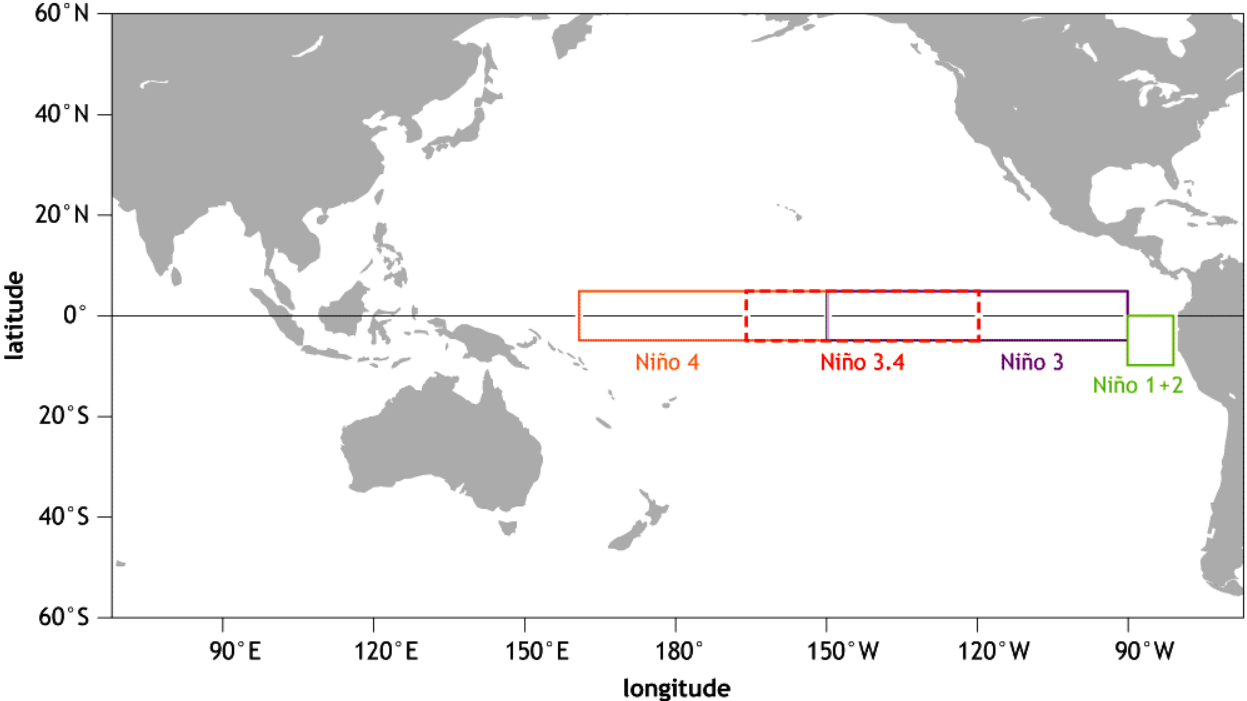
Each ENSO phase has a different influence on the tropical weather and circulation and thus impacting the weather worldwide differently. A specific phase (warm/cold) usually develops around late summer and early autumn and can last until next summer, or even up to two years in some cases.
The cold phase is called La Nina and the warm phase is called El Nino. Each ENSO phase is determined by the temperature anomalies (warmer/colder) in the ENSO 3.4 region in the tropical Pacific, as seen on the image above.
Focusing on region 3.4, you can see on the image below how the ocean temperatures dropped in summer and autumn 2020. That was the development of the La Nina last year. We saw a new cooling emerging this September, which was the start of a new cold phase, that got stronger during Fall.
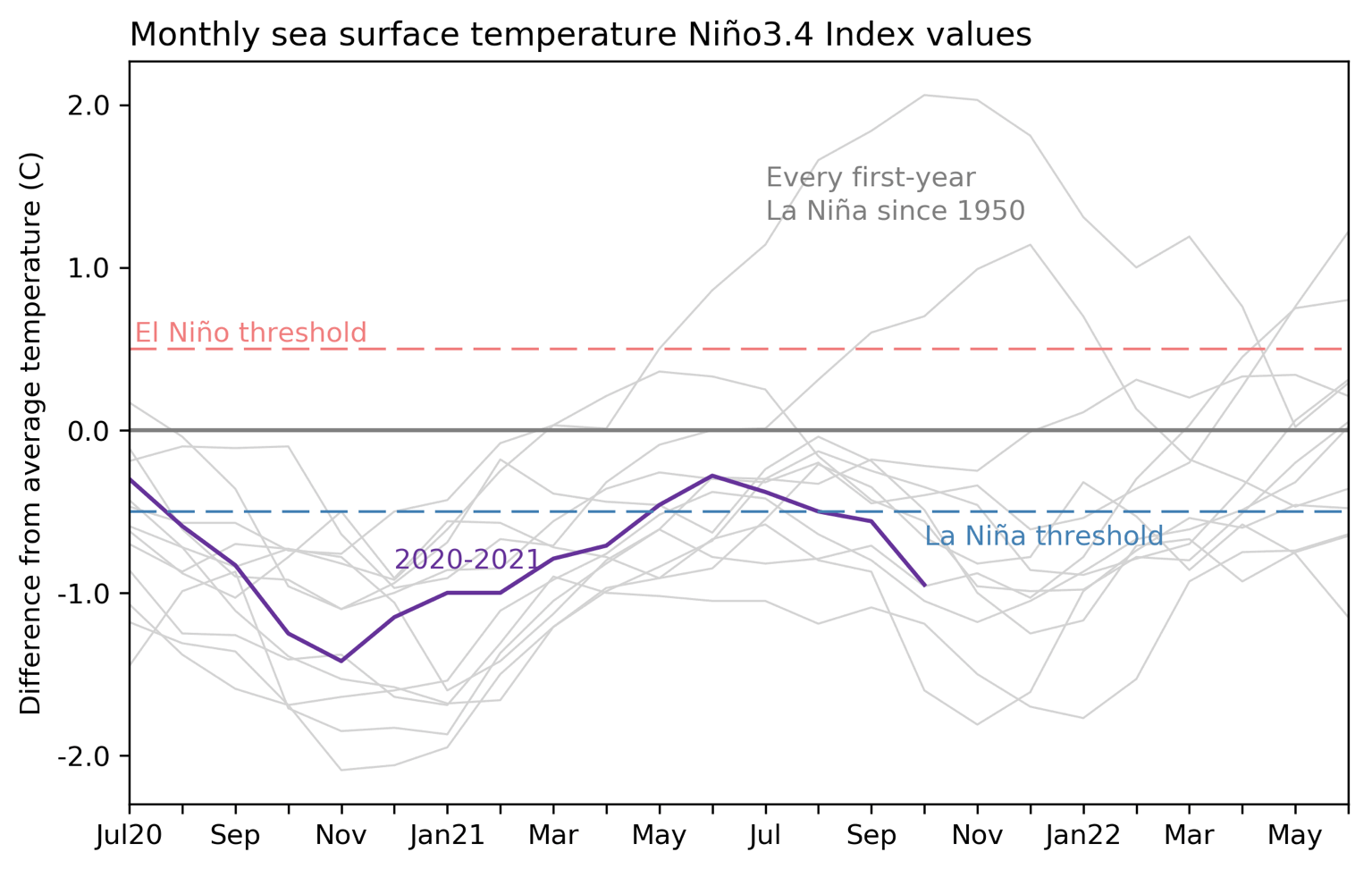
On the image below you can see the latest global ocean temperature anomaly. It reveals strongly colder than normal surface waters in the tropical Pacific regions. This is now a mature La Nina phase, spanning far across the equatorial Pacific Ocean, driven by the trade winds. We can see strong negative anomalies (-4C) in the Nino 3 region.
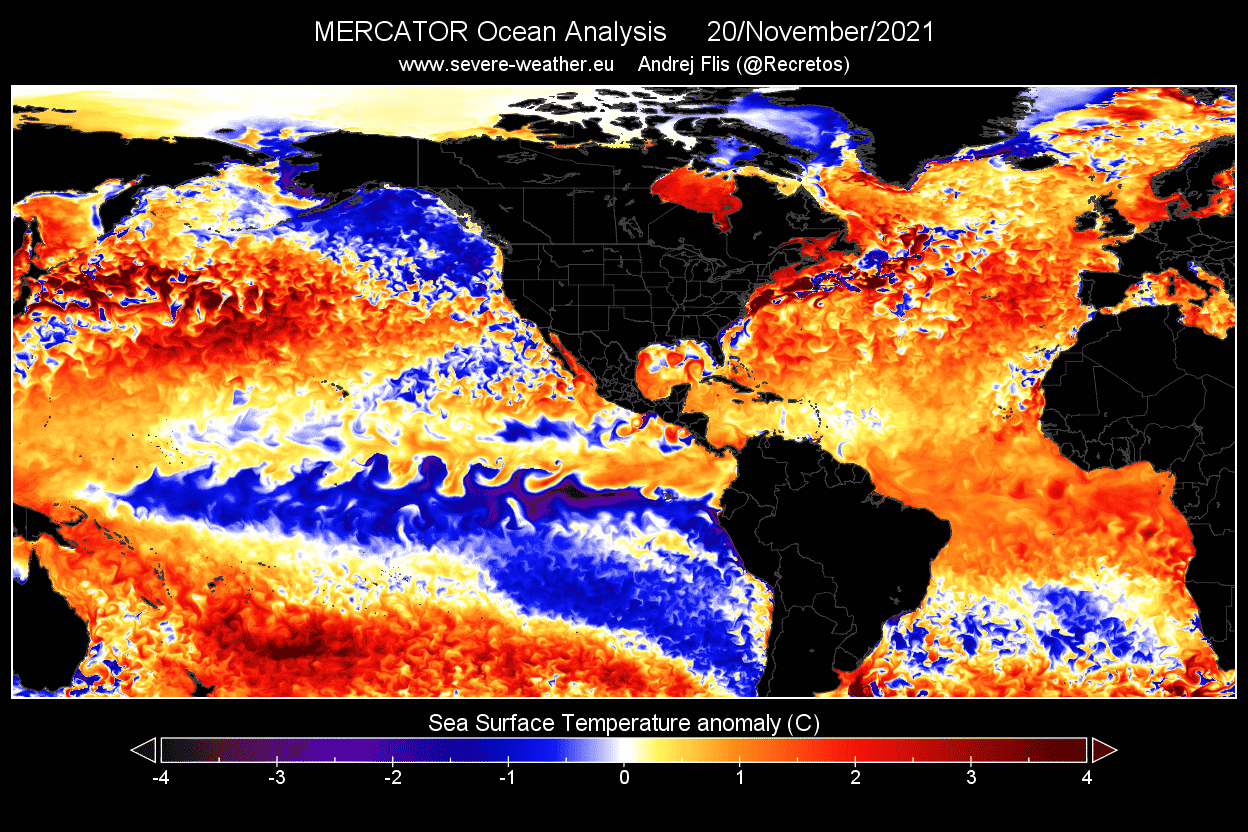
Looking back at September, the cold anomalies were much weaker over the tropical Pacific Ocean. The La Nina was just properly emerging at this point. We can also see the lack of cold temperatures in the northeast Pacific ocean compared to now.
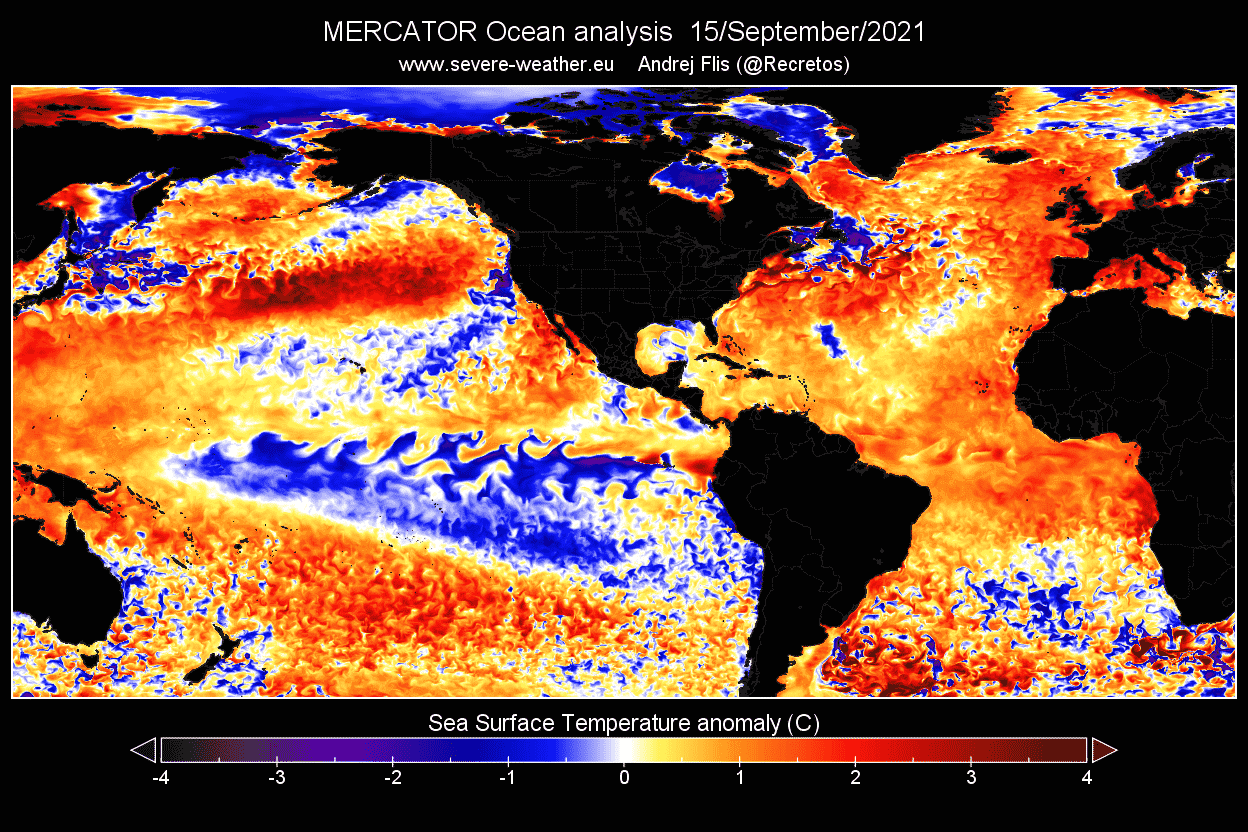
The best way to depict an emergence of a new cold ocean phase is with a high-resolution animation over time. The video below shows the cold ocean anomalies emerging in July. Notice the “waveforms” across the region, as the surface waters are being pushed west by the trade winds.
The image below is an analysis and forecast image from multiple North American long-range models. It shows the La Nina from last year weakening in Spring and a new one emerging in Fall. The forecast for this winter season shows the cold phase is expected to peak just before the winter season, with its influence reaching into early spring 2022.
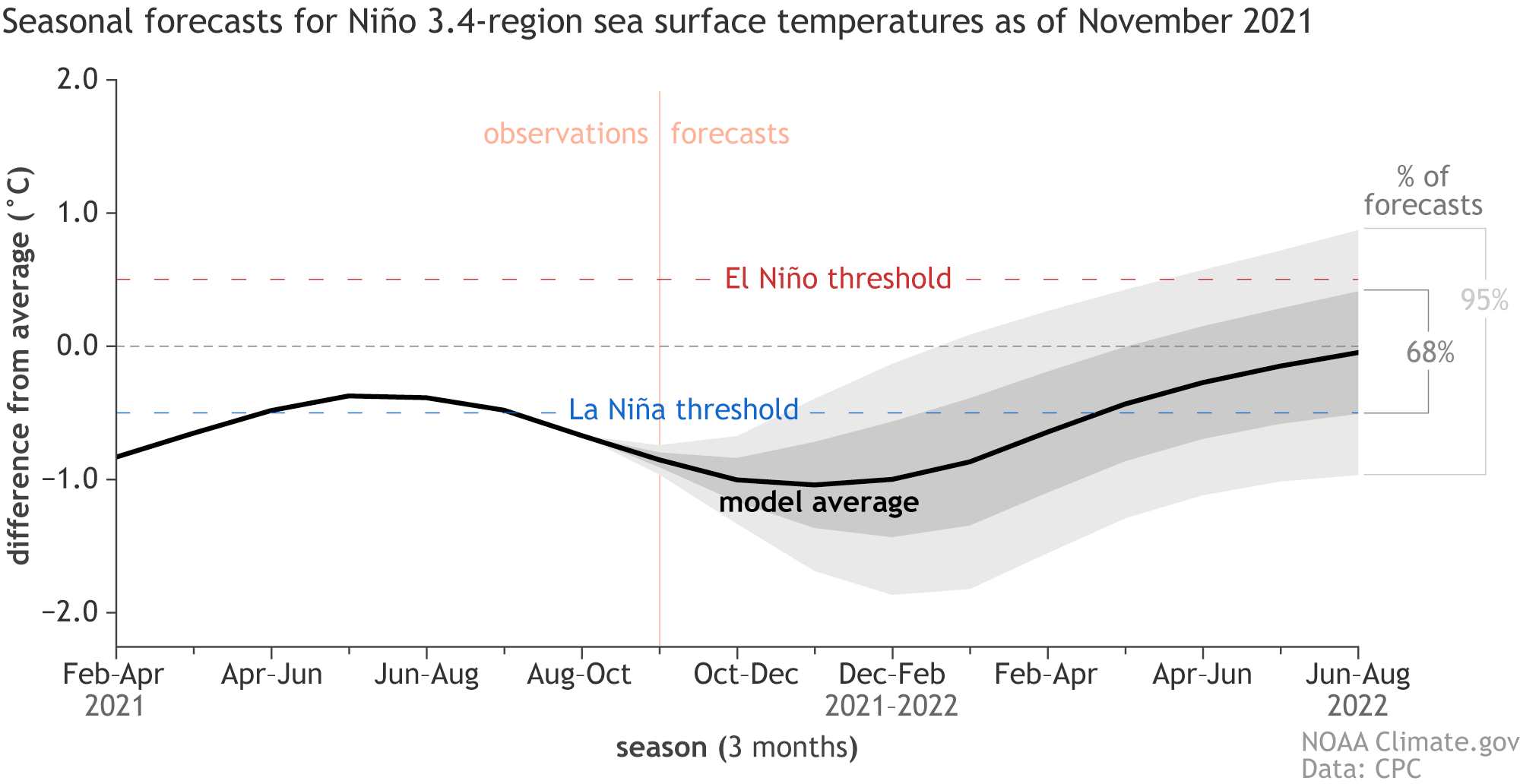
Below we have the ocean temperature forecast for the Winter season from multiple global long-range models. It shows a developed La Nina across the equatorial Pacific Ocean. It is slightly weaker compared to last year, but has a strong presence in the ocean and also in the atmosphere, as we will see in the forecast part of the article below.
We can compare the latest forecast with the forecast from September below. You can see the latest forecast above shows a stronger La Nina than initially expected. This can have a big impact on the atmospheric pressure and temperature forecast across the world, as the ocean anomalies and their strength have a different impact on the seasonal weather.
WINTER AND THE JET STREAM
Typically, the first influence of these ocean anomalies can be seen on the changing jet stream. The jet stream is a large and powerful stream of air (wind) at around 8-11km (5-7mi) altitude. It flows in a west-to-east motion around the entire Northern Hemisphere, affecting pressure systems, and their strength, shaping our weather on the surface.
Below is an example of the jet stream in winter at the 300mb level (9km/5.6mi altitude). In this example, the jet stream is quite curved down over the central United States, which brings colder air down from the north. It is curved upwards over northwestern Europe. Such formation brings colder weather to the eastern United States and stormy weather to Iceland and the British Isles.
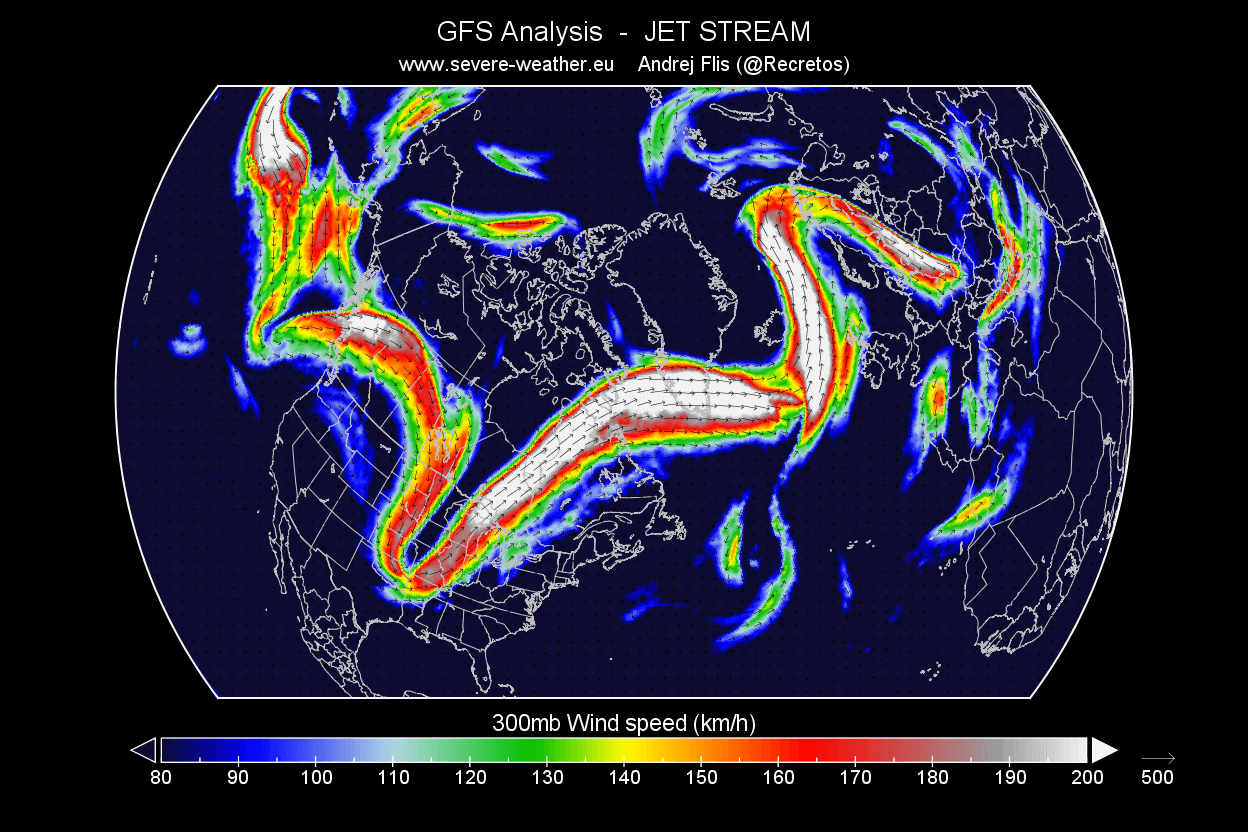
Historically, the most typical effect of a cold ENSO phase is a strong blocking high-pressure system in the North Pacific. The image below shows the average pattern during the last few cold ENSO winters. We can see the strong high-pressure system in the North Pacific and a low-pressure area over Canada and southwestern Europe. Europe is quite tricky to define the ENSO influence, as the Atlantic also plays a major role here.

The circulation of the strong high-pressure system promotes the development of a low-pressure region over Alaska and western Canada. It curves the jet stream downwards in-between the two pressure systems.
You can see that jet stream bending in the image below. The image shows the average position of the jet stream during La Nina winters and the resulting weather patterns over the United States and Canada. The shifting jet stream brings colder temperatures and storms down from the north into northern and the northwestern United States, and warmer and drier weather to the southern parts.

This way, the changing jet stream over the United States can actually divide the country into 2 weather poles. The images below show the temperature and precipitation analysis during the past La Nina winters over the United States.
In the northern part of the country, we see that the colder and wetter events are more frequent, as the jet stream directions the storm systems that way. But that can somewhat lockout the southern United States, creating warmer and more stable weather with less frequent storms and cold fronts.

Looking at the precipitation pattern, we can see more precipitation in the northern half of the United States. That is where most of the cold fronts and storms systems travel over during a La Nina winter. In contrast, drier conditions prevail in the southern and southeastern states. Of course, this doesn’t mean that a cold front cant reach down into Texas for example if a break in the weather pattern permits it.

Shifting the jet stream also means changing the snowfall potential. As the colder air is more easily accessible to the northern United States, that also increases the snowfall potential if there is moisture available. Especially areas like Alaska, Canada, and the northwest and the northern United States benefit from the jet stream to produce more snowfall. The graphic is provided by NOAA-Climate.
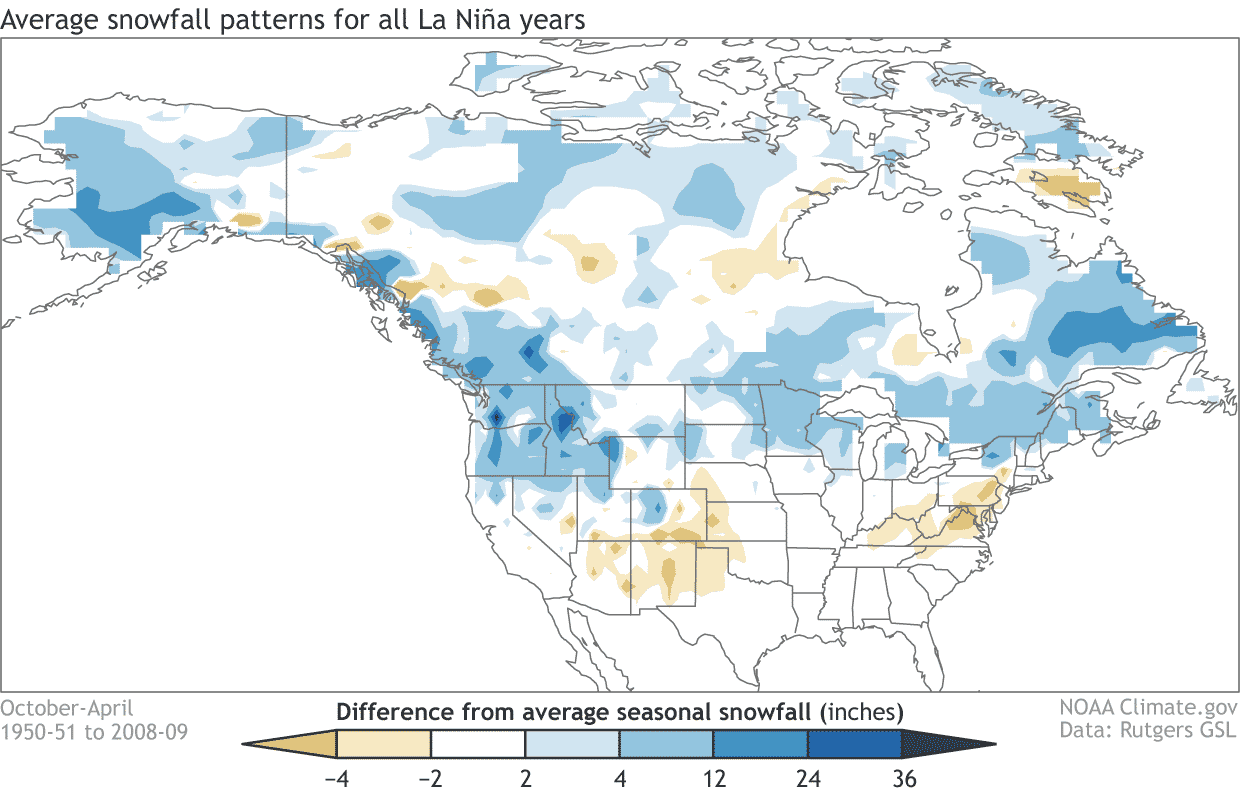
After passing Canada and the United States, the jet stream moves out into the North Atlantic. There are different paths it can take from there. A lot depends on the overall circulation pattern and the existing pressure systems in the Atlantic. This is where La Nina perhaps loses its direct influence over Europe, as regional weather systems in the Atlantic play a role.
But it usually still has an important influence, as it changes the position of the entering jet stream from the west. The incoming jet stream can merge with the systems in the Atlantic, helping to create a whole new weather pattern for Europe. The problem is that the final outcome is far more unpredictable in this region compared to North America, which feels a much more direct weather influence.
WINTER SEASON 2021/2022 FORECAST
We now know what La Nina is, and how it can change the jet stream and our weather. Now we will take a look at the global long-range models, and how they see the developing Winter 2021/2022.
We decided to focus on the 3 main (or most used) seasonal models. The ECMWF and UKMO from Europe, and the CFSv2 from the United States. Graphics are from the Copernicus Climate EU project and the CPC/NCEP.
All these forecasts are an average picture over the course of 3 meteorological winter months (December-January-February) and show the general prevailing weather patterns. Even if the models would be completely accurate, it does not mean that such weather conditions would last for 3 months straight. It only suggests how the weather patterns might look 40-60% of the time.
ECMWF WINTER SEASON FORECAST
The ECMWF model is most often referred to as the most reliable model, at least in the long-range category. In reality, a lot depends on the individual seasons. But generally, the ECMWF model is at the top of the chart as far as reliability goes. But no long-range/seasonal forecast can ever be deemed “reliable“, as we are only looking at trends and how the weather patterns might evolve on a large scale.
In the pressure pattern forecast from ECMWF below, we can see the typical La Nina high-pressure system in the North Pacific. The low-pressure system is developed over western Canada and the jet stream is bending in between the two pressure systems, just like we have seen in the previous segment.
We also see the North Atlantic in a positive North Atlantic Oscillation (NAO) mode, which means an amplified jet stream over the British Isles and into Scandinavia. But this is not a typical positive NAO setup and is also a weaker one. It still allows for winter situations over Europe. Most likely if the high-pressure system in the central Atlantic can take over the North Atlantic for a while, creating a more northerly flow over Europe.
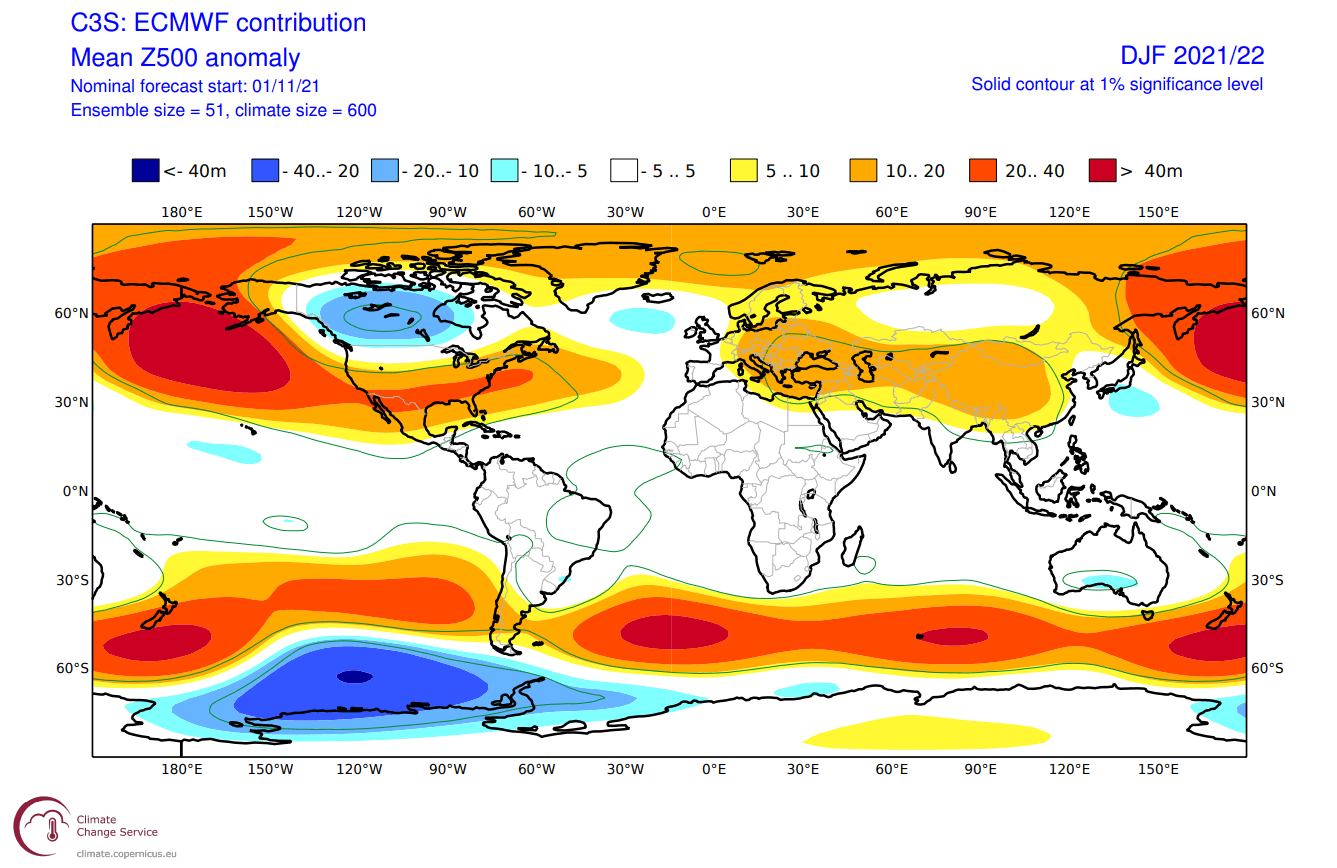
The airmass temperature forecast below shows North America divided into two parts. Western and central Canada is forecast to be colder than normal. Thanks to the jet stream, there is a high chance of the colder air extending south, into the parts of the northern United States and over the Midwest, and into the northeastern United States. The Southern United States is forecast to be warmer than normal.
Europe also features higher than normal temperatures. A more westerly flow dominant scenario is suggested, but the pressure pattern does allow for a break in the flow. Occasional cold flow from northwest Europe is possible down into the mainland.

Looking closer at Europe, we see the surface temperatures are mostly above normal. Higher temperature anomalies and milder conditions are more likely towards the eastern regions. Central and western regions are likely to see occasional cold fronts from the northwest, hence the lower magnitude of the warm anomaly.

Over Noth America, the ECMWF forecast shows colder than normal temperatures over much of Alaska and western Canada. We do see an indication of colder air intruding into the northwestern United States and the Midwest. Warmer than normal temperatures are forecast for the southern regions.

Despite being shown warmer than normal, the central and northeastern parts of the United States tend to get occasional colder weather and snow during these jet stream patterns.
The precipitation anomaly forecast below shows a more normal La Nina type pattern over Canada and the United States. We see the mainland United States with wetter conditions in the northern parts under the jet stream and drier conditions in the south-central regions.
Europe is shown to have more precipitation over the northern regions, where most of the low-pressure systems will move. We still see wetter conditions in the Mediterranean. That would mean occasional breaks in the westerly flow and a low-pressure system over southern parts, as hinted in the forecast.
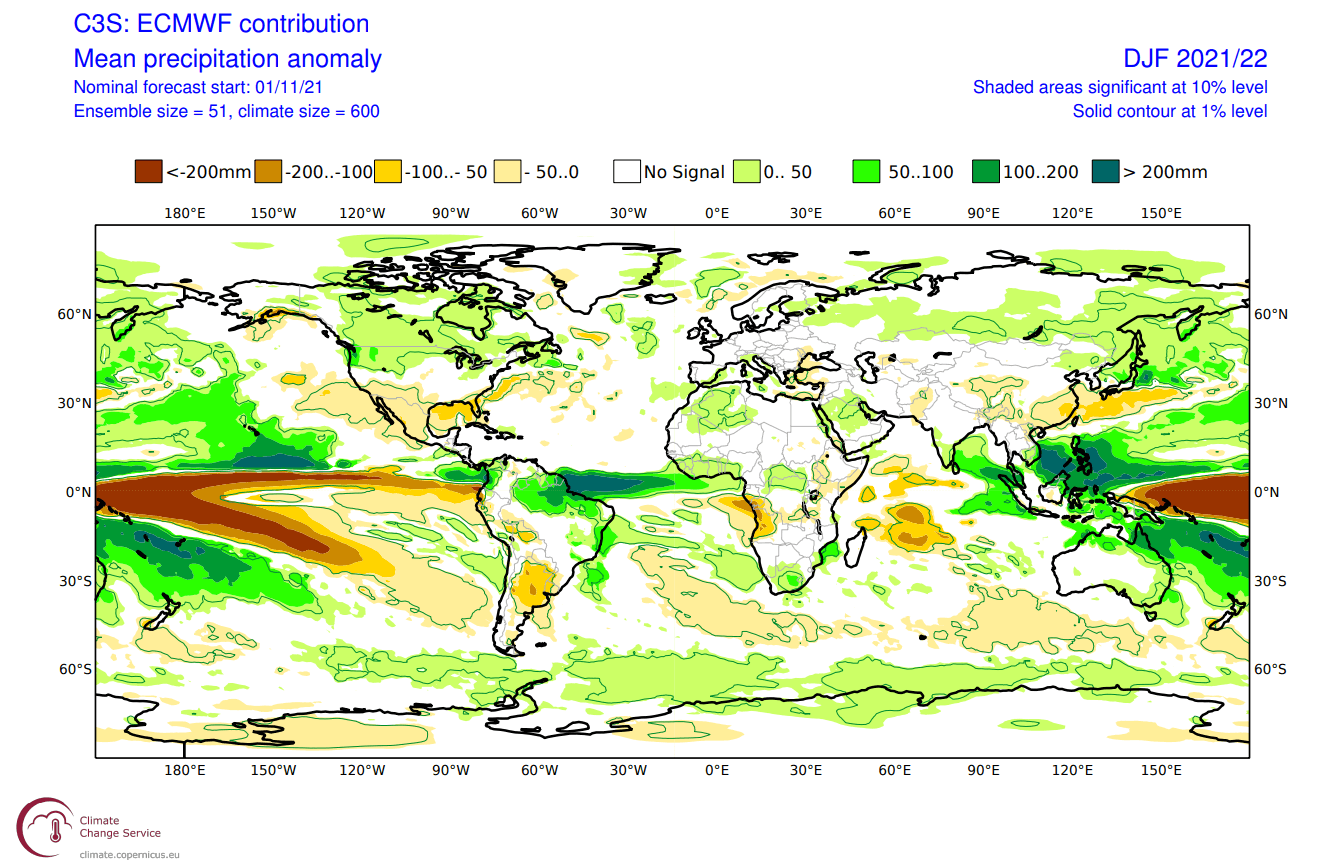
We produced a special snowfall forecast from the ECMWF data, provided by the Copernicus-EU project. Over Europe, we see mostly above-normal snowfall in the central and eastern regions. The exceptions are the northern United Kingdom and most of Scandinavia.
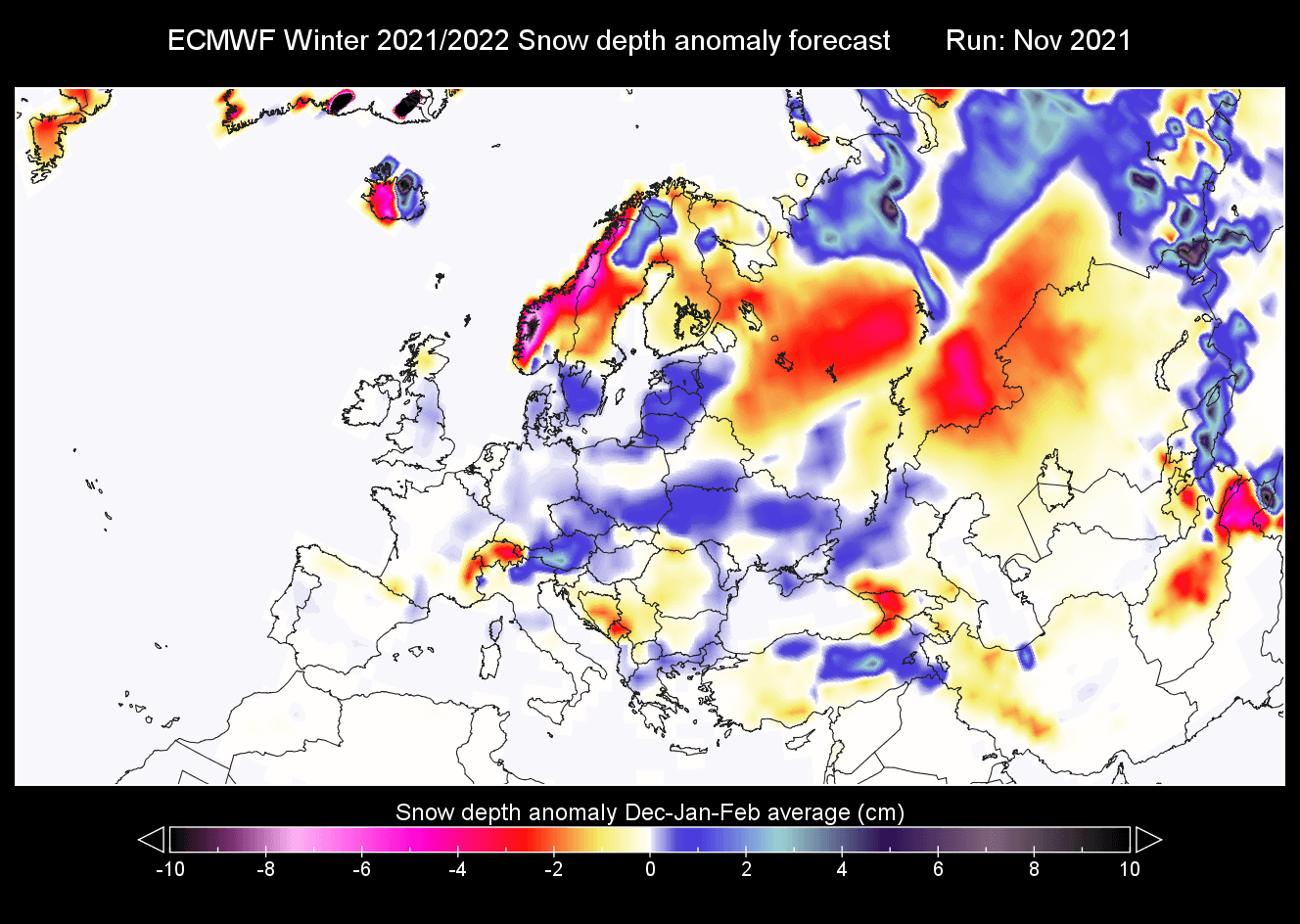
Over North America, we see a very interesting snowfall forecast. ECMWF suggests more snowfall than usual in most of the northern United States, especially in the western states. The increased snowfall potential continues over the Midwest and into the northeastern United States. We can also see a small extension of more snowfall down into the south-central regions.
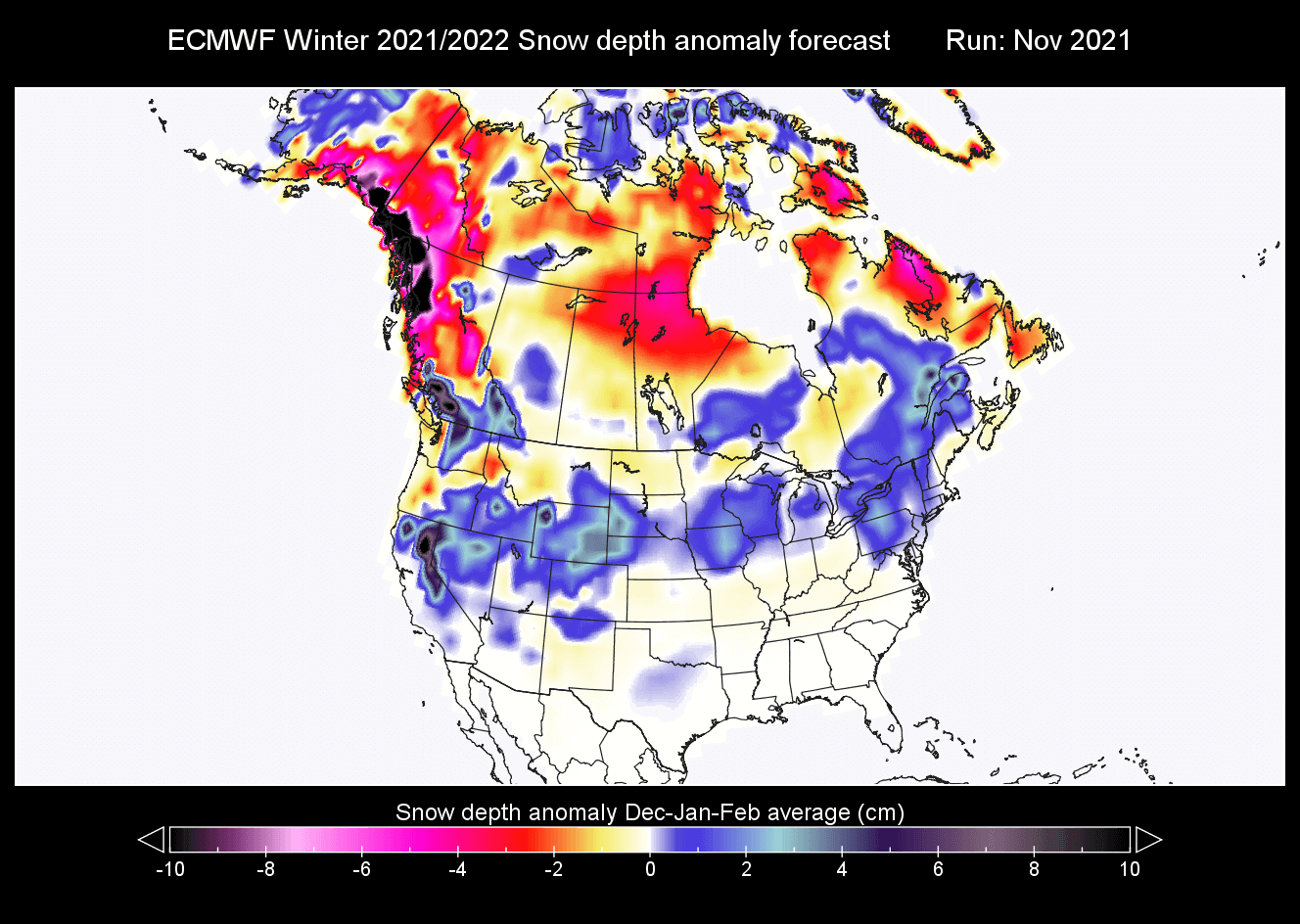
UKMO WINTER SEASON FORECAST
Our second model of choice is the UKMO model, from the United Kingdom Met-Office. This has also been a good performer in the past winters, so we tend to include it in our standard “package” of model forecasts.
UKMO has a slightly different pattern than the ECMWF, and quite honestly it seems just as likely at the current point in time. It shows the strong La Nina blocking high-pressure in the Pacific. But the main low-pressure area over western Canada is weaker, and the low-pressure zone in the North Atlantic is stronger.
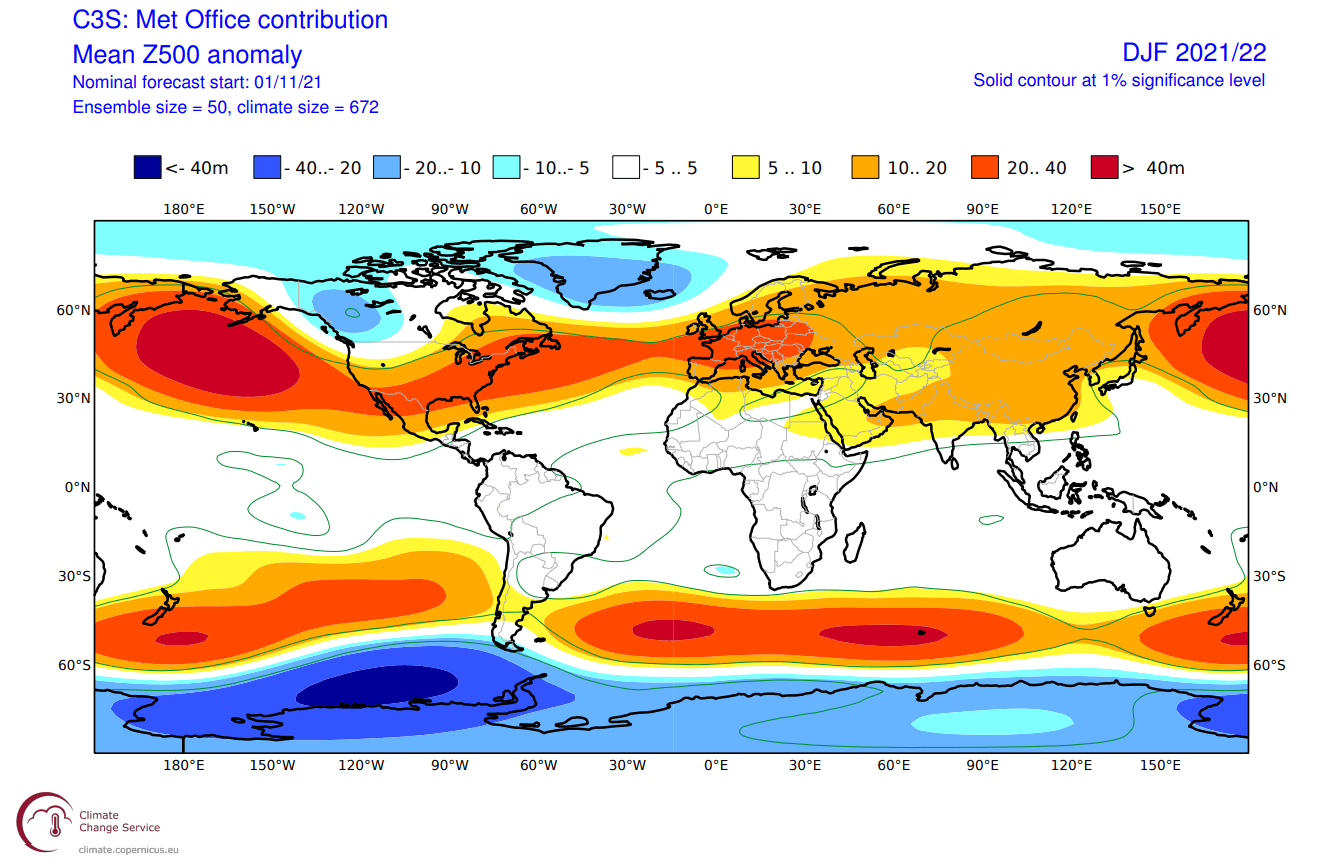
This is a much stronger positive NAO pattern, creating an amplified jet stream into northern Europe and a high-pressure zone over Europe.
The temperature forecast however still looks similar to the ECMWF. Over North America we have the cold pool over western Canada and Alaska, reaching down into the northwestern United States. The southern and eastern United States is forecast to be warmer than normal by the UKMO model.
Europe features mostly warmer than normal conditions, with a storm track further up over northern Europe.
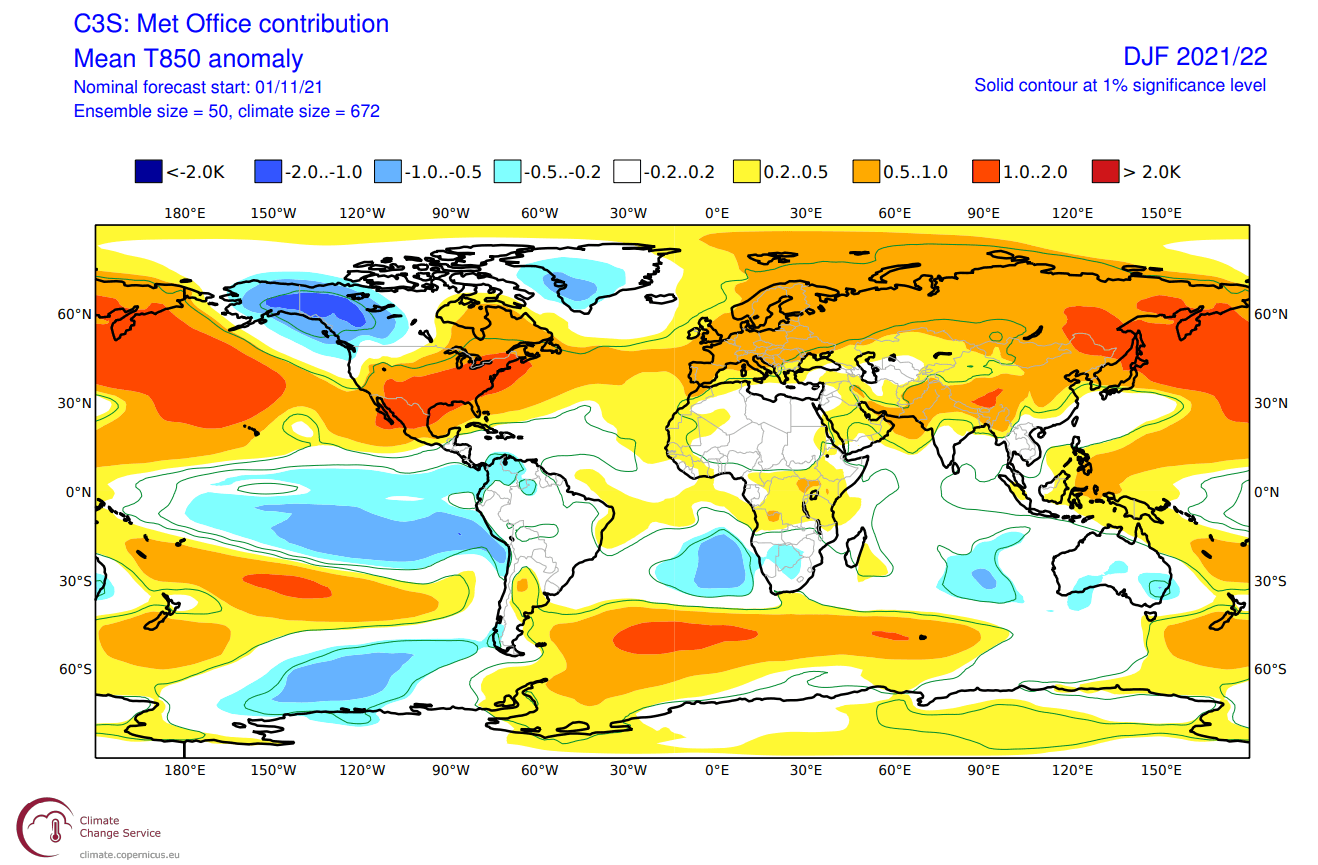
Looking closer at Europe, we see the stronger warm anomalies focused over central and northeastern regions. The western half has weaker warm anomalies. That indicates an increased potential for northerly flow and cold fronts into the western regions from the northwest, as the pattern occasionally breaks down.

Over North America, we see the double weather pole. Cold up north in western Canada, and warmer down in the United States. The exception is the northwestern United States and the Midwest, which shows an extension of near-normal temperatures. That is likely the pathway for cold air spills down from Canada.

The precipitation forecast also nicely shows the “dipole” pattern over the United States, with drier in the south and wetter in the northern parts. Northern parts of the United States also have a higher chance of more snowfall, under the jet stream. Europe features higher precipitation over northern regions, due to the higher frequency of storms moving over this area.

CFSv2 WINTER SEASON FORECAST
As a counter-balance to European models, we usually use the main North American long-range model, the CFS version 2 from the NOAA/NCEP in the United States.
The CFS model is closer to the UKMO, with the strong high-pressure system in the Pacific and the Low-pressure system over eastern Canada and the North Atlantic. This is the more typical La Nina situation we have mentioned before. The jet stream in the North Atlantic bends northeastward, over the British Isles and into Scandinavia, which is a typical positive NAO pattern.

Airmass temperatures are most interesting over North America, with a strong cold air anomaly in Canada and warmer air in the southern United States. Europe is seen warmer than normal, as expected with storms moving far out in northern Europe, locking out the colder air for most of the time.

Looking closer at Europe, the surface temperatures are really warmer than normal over much of the continent, especially central and eastern regions. This is very similar to the other two seasonal models presented above and seems to be a consolidated (high-reliability) forecast at this point.
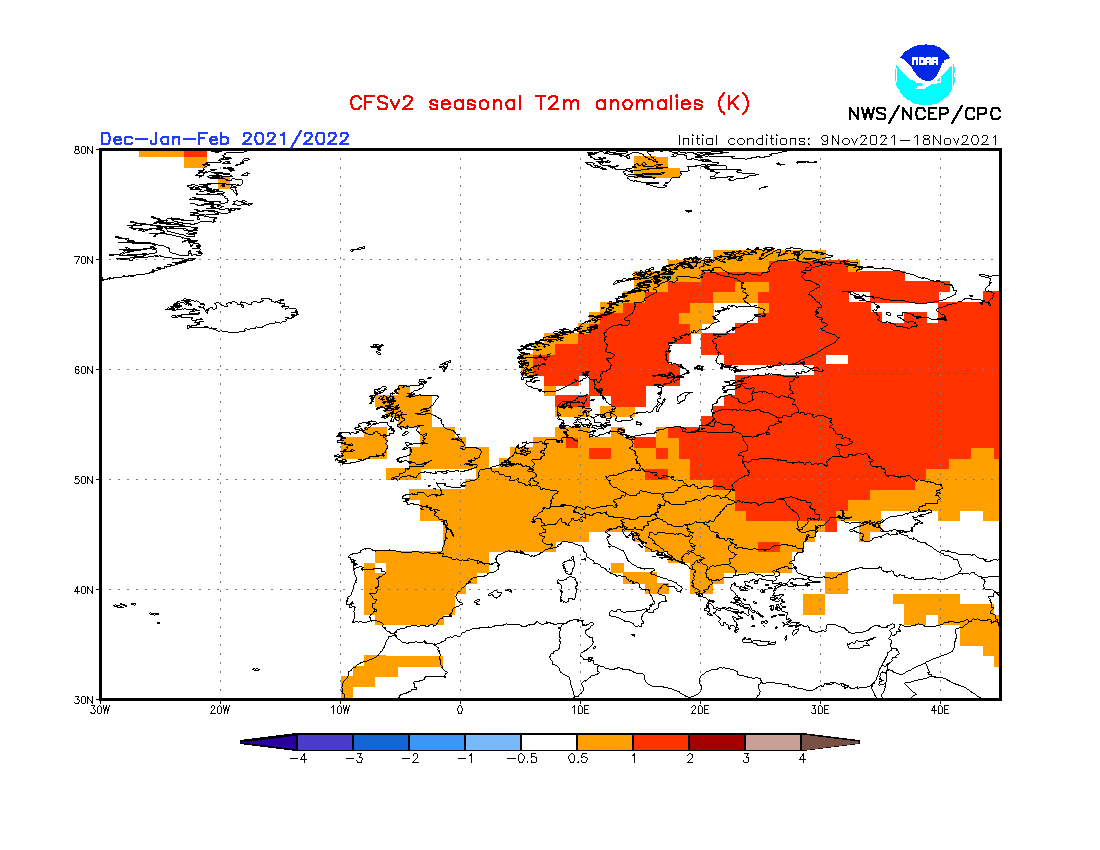
The North American forecast shows a really strong dipole pattern. Much colder than normal temperatures over most of western and central Canada, and warmth over the southern parts of the United States. The colder anomalies extend down into the northern United States, especially the Midwest, and partially into the central states.

As far as precipitation goes, Europe is forecast to have more precipitation over the northern half. The central and southern parts of the continent are expected to have less precipitation than normal, and a drier winter season.

The precipitation anomaly forecast below for North America shows the main weather dynamics (with increased precipitation) over the northwestern and eastern parts of the United States. Drier than normal conditions are forecast for the southern end. Especially worrying is the dry area in California, which is already under severe drought conditions.

We have to keep in mind that most of the strong weather dynamics happen between the cold and warm anomalies, including snowfall. CFS has no snow depth forecast graphic, but this temperature and precipitation pattern would likely look similar to the ECMWF snowfall forecast seen earlier above.
WINTER FORECAST SUMMARY
Reading images and descriptions can be somewhat confusing. So to simplify everything, here is what the latest Winter season 2021/2022 forecast has to offer:
Europe is expected to have warmer than average temperatures over most of the continent, getting stronger towards the east. This, however, does not mean that there will be no cold fronts and colder days. It just implies that cold fronts and colder air mass intrusions will be less frequent over the region. Western Europe is likely to see more frequent colder air intrusions than eastern Europe.
The models are not in 100% agreement over the pattern in the North Atlantic. The main key is the positioning and strength of the low-pressure over Iceland/Greenland. The average picture from all three models suggests lower pressure in this region, limiting the cold air intrusions into the continent.
Normal to wetter conditions are expected over northern Europe. The British Isles and Scandinavia could have a more unsettled winter, as the jet stream positions over these regions, bringing along stormy weather. Mainland Europe is expected to experience drier conditions, with above-average precipitation likely in the Mediterranean.
North America winter forecast looks fairly solid to be a classical La Nina type winter. Most of western and Central Canada is to expect colder and snowier conditions, along with Alaska.
The United States can expect to see a “two-faced” pattern or a “two-faced” winter. The Northern United States is expected to be normal-to-colder this winter with more precipitation. This increases the chance of snowfall, but more likely towards the western half and in the Midwest, with the lesser degree in the northeastern United States.
The Southern United States has a high chance for warmer and mostly drier than normal winter weather. This however does not imply that no cold front can reach the southern states. It just implies that in a La Nina pattern, it is much less likely to get frequent cold fronts down to the very south.
Below we have the official temperature forecast for the United States by NOAA. It shows the temperature probability, with colder to equal chances in the northern United States. The southern half of the country and the northeast have a higher probability of warmer than normal weather, which we saw in the models above.
The official precipitation forecast is also quite similar to the models above. We see an equal-to-higher probability for more precipitation (and snowfall) in the northwestern and the northeastern United States. The Southern United States is forecast to have a drier than normal winter season.
The problem with precipitation in a La Nina winter is usually the persistence of drought conditions in the south and southwest. Below we have the latest drought graphic from NOAA, which shows the current drought conditions in the United States. We see strong drought conditions over much of the western United States.
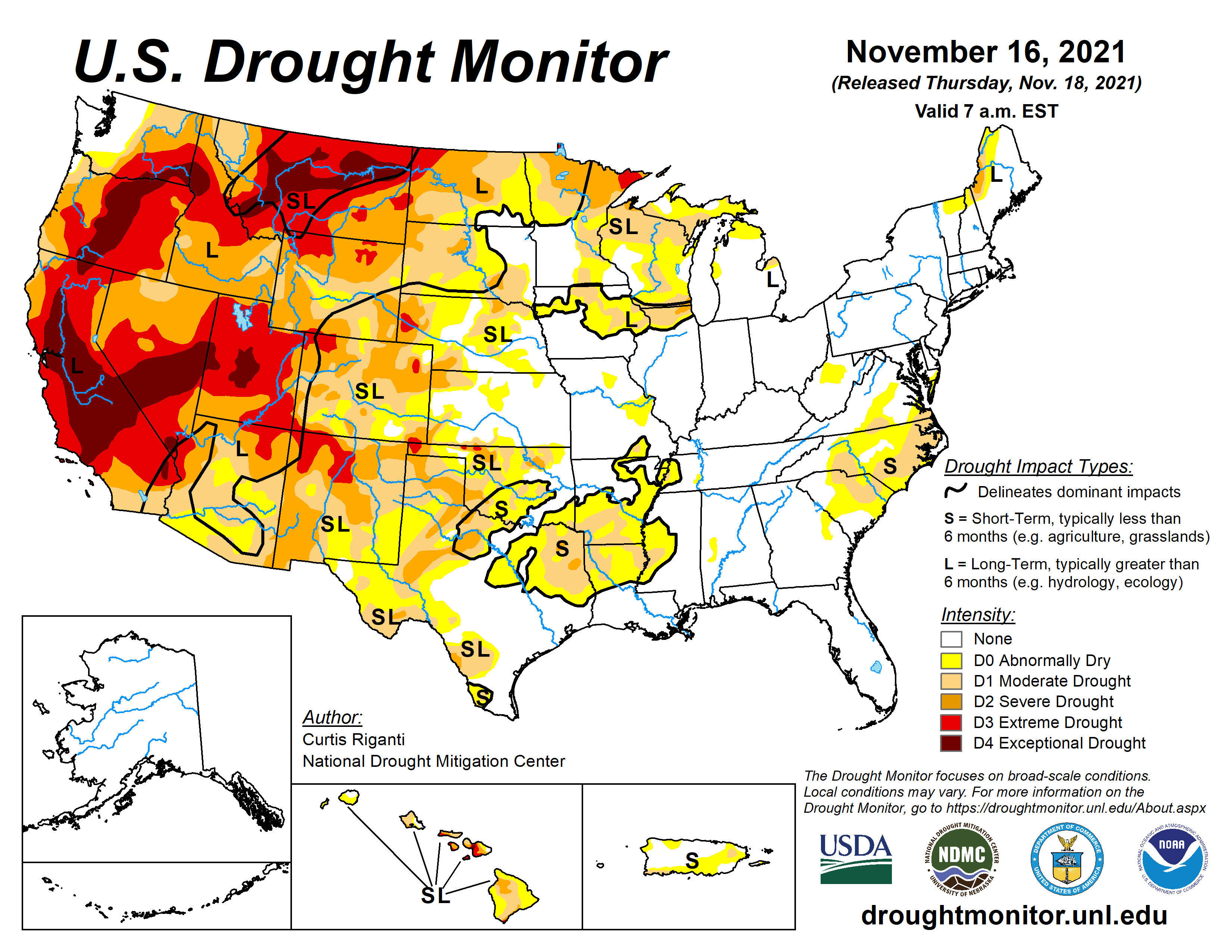
The northwestern United States is likely to recover to some degree during the winter season, as we have seen on the precipitation forecasts. But the drought conditions in the southwest are expected to continue, and likely even get worse in a La Nina Winter.
The entire southwest and especially California is expected to have continued drought conditions through the winter season. Drought conditions are likely to be declared in the southern states as well over the winter, as La Nina is known to produce less precipitation in the southern states during the winter.
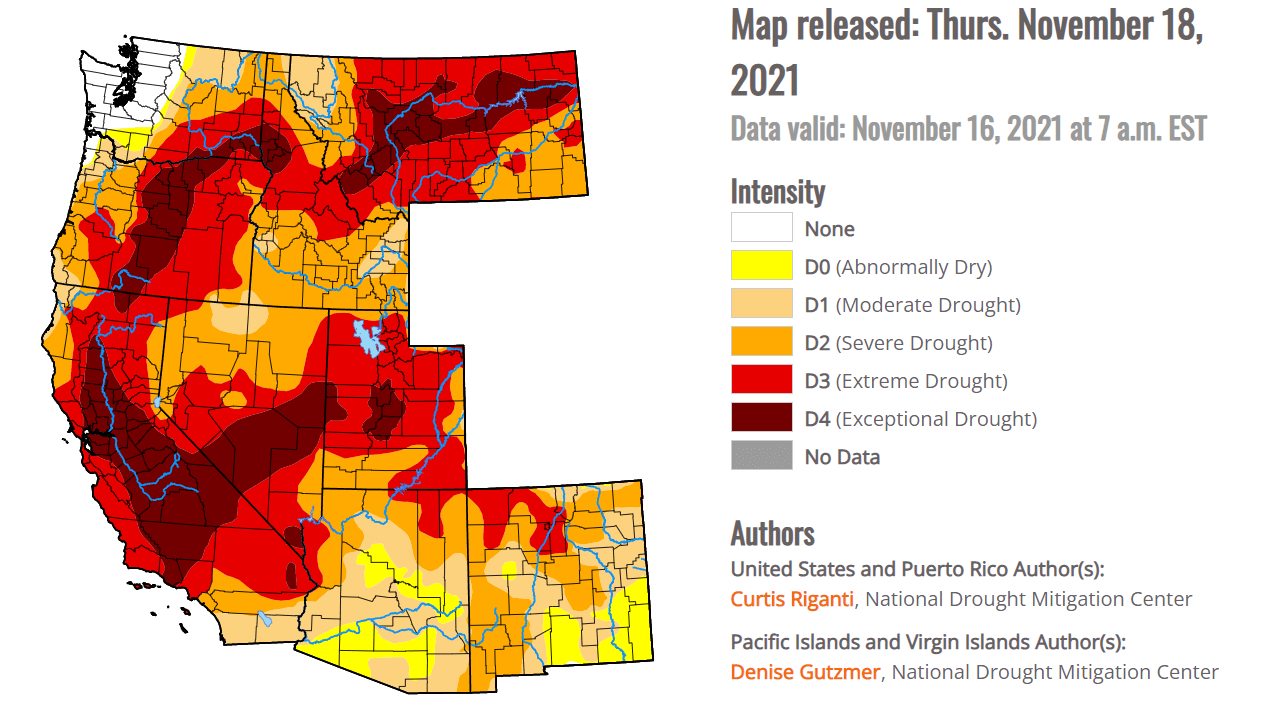
STRATOSPHERIC WARMING
One of the more important sources of winter weather dynamics is the well-known polar stratosphere and the Polar Vortex. At the bottom of the page, you can find a link to our Polar Vortex and Stratosphere article. It contains info on what the stratospheric Polar Vortex is and how it can influence the winter weather.
A Sudden Stratospheric Warming event (SSW) can have a major impact on the circulation and can cause major pressure changes in the Northern Hemisphere. So a potential SSW event is an important factor that can change the course of winter weather in either direction on a large scale.
Below is an image that shows an average temperature pattern 0-30 days after a stratospheric warming event. High pressure over the Arctic helps to unlock the cold air out of the Arctic regions, sending it down into the mid-latitudes of the United States and Europe. Not every stratospheric warming event produces this pattern, but this is an average image of many events in the past 40 years.
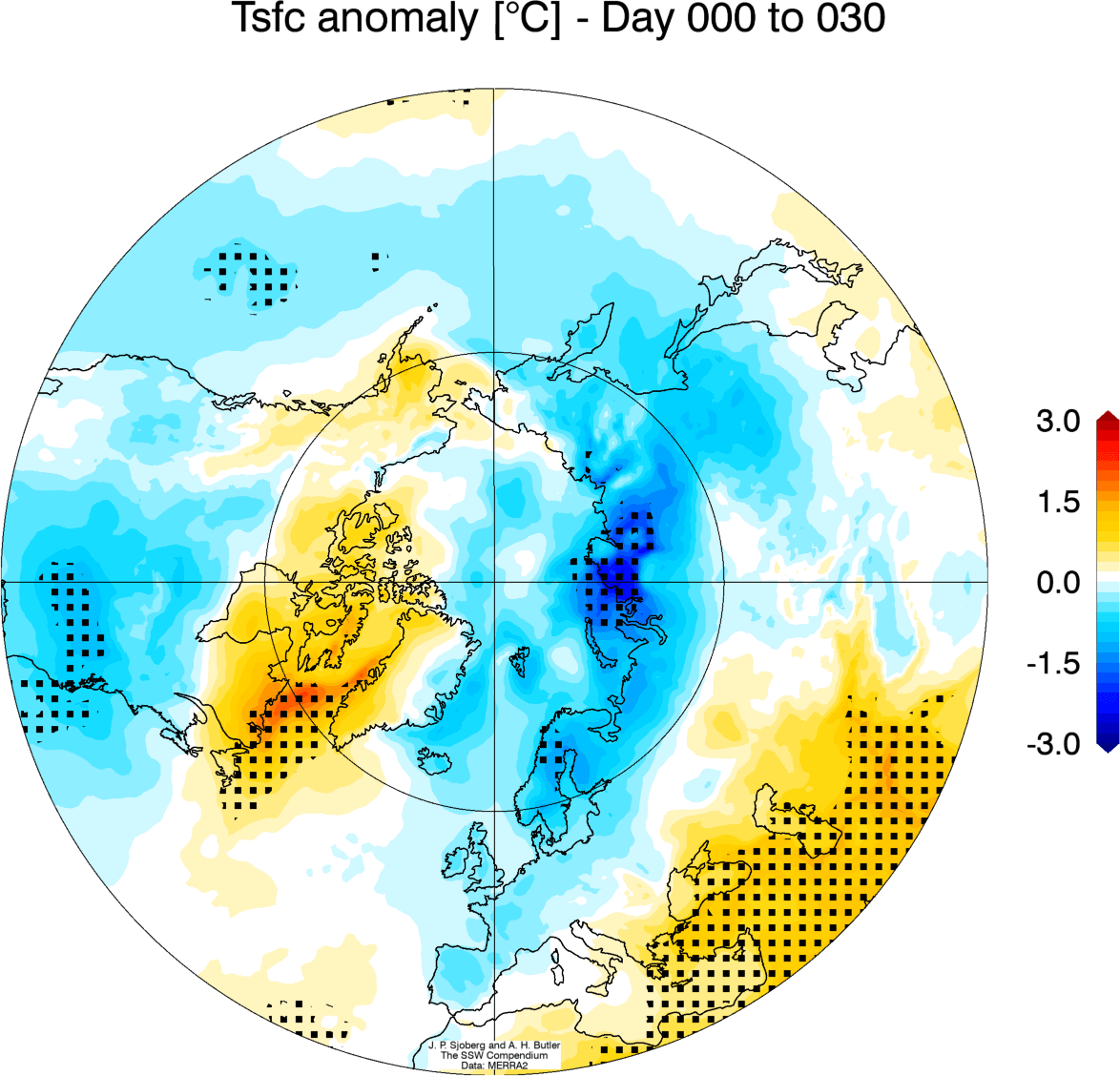
We actually had a strong stratospheric warming event last winter, which changed the weather circulation patterns and helped to produce the strong cold outbreak in the southern United States in February 2021.
Below you can see strong positive values in the stratosphere in early January, associated with the higher pressure buildup during a stratospheric warming event. The pressure rose during the warming in the stratosphere, descending down over time, reaching the surface levels by mid and late January. This persisted well into February, influencing the weather circulation and releasing colder air out of the Arctic (negative AO index on the bottom).

We produced an analysis of the January-February 2021 winter period, showing pressure anomalies on the image below. You can see a strong high-pressure system over the North Pole. This dominant high-pressure system originated from the stratospheric warming event and the polar vortex collapse, as we saw in the previous image.
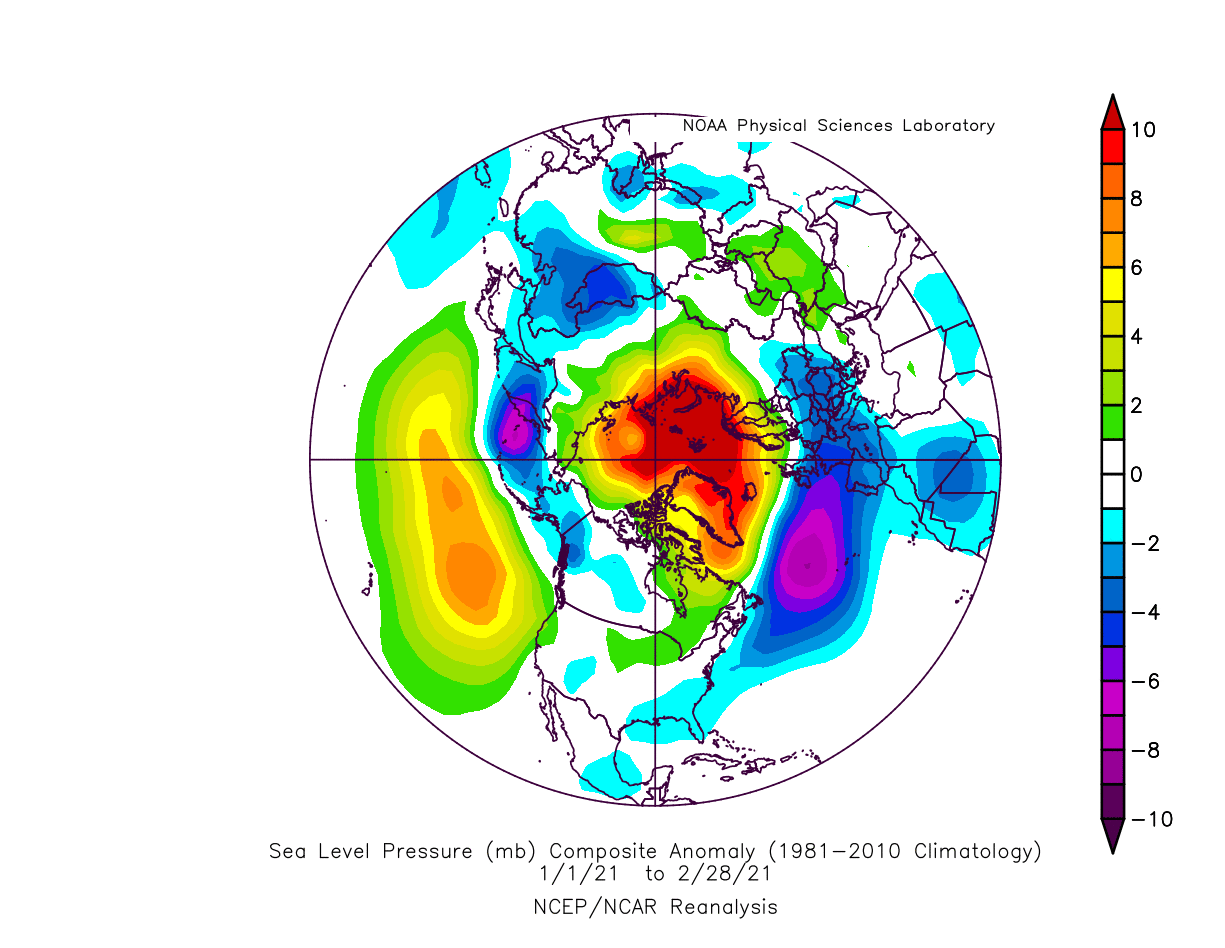
A strong high-pressure system over the Arctic can heavily disrupt the weather circulation and can unlock the cold air from the Arctic regions towards the mid-latitudes.
Long-range forecasts are generally not as good at forecasting stratospheric dynamics in detail. This means they tend to underestimate any potential Sudden Stratospheric Warming events (SSW). That is because the final forecast is made out of many individual calculations, which have different ideas about stratospheric development.
Below we have the ECMWF stratospheric forecast. It shows the wind speed in the stratospheric polar vortex, which is directly related to its strength. An SSW event normally features a reversal of the winds in the stratosphere (negative values).
We can see an obvious weakening of the polar vortex in late December and early January 2022. No SSW event is indicated in the main forecast, but this does hint at potential disruption for the polar vortex. We do have some individual calculations going into the negative values (SSW). This is the likely window of opportunity for a stratospheric event to occur in this Winter season.
You can read more about the polar vortex and the stratosphere for the upcoming winter, in our specialized article linked below:
Winter Season 2021/2022 and the Polar Vortex
We will keep you updated on the developing weather trends in the coming seasons, so make sure to bookmark our page. Also, if you have seen this article in the Google App (Discover) feed, click the like button (♥) there to see more of our forecasts and our latest articles on weather and nature in general.
Dont miss: